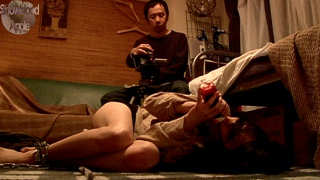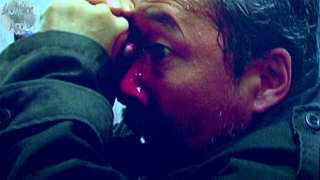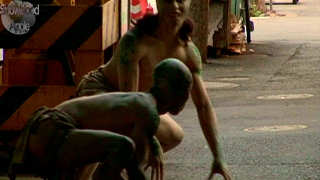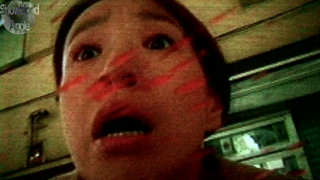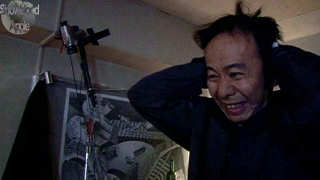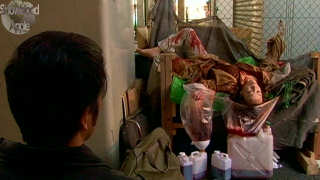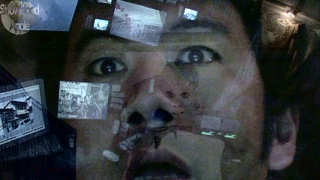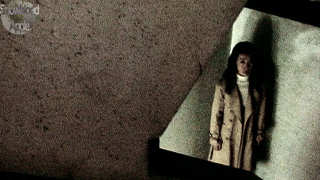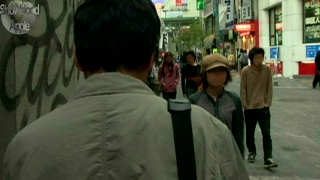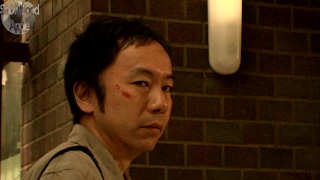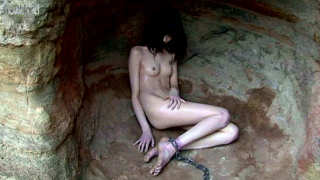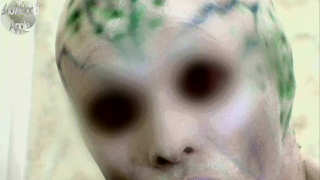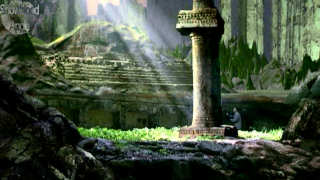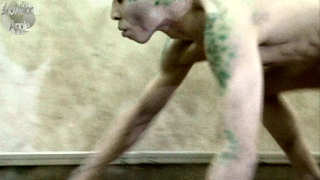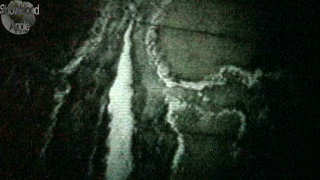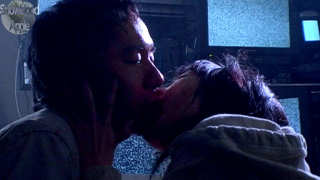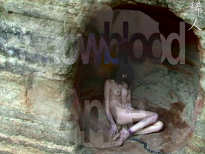 Review © Mandi Apple, 2005. |
|||||||||||||||||||||||||
Directed by Shimizu Takashi, 2004, 92 mins., starring Shinya Tsukamoto, Tomomi Miyashita, Kazuhiro Nakahara, Miho Ninagawa and Shun Sugata.
Right from the get-go, I have to say that Marebito (or in literal translation, The Stranger From Afar), directed by Shimizu Takashi and starring Shinya Tsukamoto, is seriously, seriously, severely weird. Weirder than a whole bag of weird bought cheap at a weird sale. A complete departure (and a thankful one) from cranking out Ju-on after Grudge after Ju-on: The Grudge etc etc etc, with Marebito Shimizu creates a new mythology based on old historical occult practice and theory, other people's fiction, and urban legends. Part ghost story, part myth, part mad fantasy and part vampire tale, Marebito is as complex, dark and subterranean as its subject matter. Stylistically, the movie relies a lot on the old-fashioned but eternally effective device of showing the viewer something tiny and subtle to make them think "Hang on a moment, did I just see what I thought I saw?" - something employed to great effect in The Eye, among others (the best example I have personally seen of its use to date was in the UK TV fake documentary drama Ghostwatch which has scared the crap out of a generation of Brits) but something which Shimizu has not used much before himself, usually preferring to shove the horror into the viewer's face rather than showing them something out of the corner of their eye. But in true Shimizu fashion, he can't resist lots of shots flaunting horrific imagery full in your face too. If Marebito can be compared to anything, it is to the geometric, hypnotic and bizarre work of the Belgian artist M.C. Escher, and it is notable that the poster featured on the central character's apartment wall is indeed one of his best-known works Relativity (1953) - featuring a downward and impossible spiral of staircases in an infinite loop, which speaks volumes about this movie. From the acting side, Shinya Tsukamoto is as hypnotic, brilliant and charismatic as ever. His understanding and conveyance of the material is unparalleled - no-one could have a finer actor to lend a piece credibility and realism, and the supporting cast are pretty good, although clearly it's Tsukamoto who carries the entire film. The look is glossy and stylish, from the cheap but effective shots of the ethereal and odd world under the world, to the hyperreal and somewhat trancelike way the surface world is portrayed - it works on every level. Beautiful cinematography recalling the work of Kiyoshi Kurosawa (particularly Kourei and Kairo) sets Marebito apart from the crowd. From the soundtrack side, the movie again references Kurosawa's back catalogue, utilising the industrial and organic soundscapes devoid of conventional music with which Kurosawa is so fond of creating his bleak atmospherics.
Synopsis Takuyoshi Masuoka (Shinya Tsukamoto) is a professional freelance cameraman, Prozac-popping depressive and private voyeur who loves to tape unsuspecting people's windows, then transfer his recordings to PC and watch them in the privacy of his own apartment as his rather twisted hobby. He manages to tape a suicide at a metro station quite by accident one day: it is shown on the news with the suicide victim's face blanked out, but of course he has his own uncut version to compare it with. The man in question, Arei Kuroki (Kazuhiro Nakahara), has chosen a really odd way to kill himself - by knifing himself in the eyeball. Takuyoshi has become obsessed with Kuroki's death due to the look of absolute horror on his face, and he wonders if he stabbed his own eyeball out to prevent him from seeing whatever made him so afraid. But being a voyeur, and almost pathologically nosy with it, he wants to see whatever it was that this man saw to drive him to suicide. He genuinely wants to experience this peculiar suicidal terror sensation for himself, to see how Kuroki felt when he was pushed to carry it through. When he watches back his recent footage again, this time he sees something odd happen - the suicide victim's eyes flick towards him on the screen, which did not happen in real life - and suddenly the multiple screens showing his footage go mad, flooding his senses with super-sped up imagery, including a weird, insectile, creepy bald female figure crawling out of a strange metal door. This leads Takuyoshi to think that whatever it was that terrified Kuroki so much came from underground, which is, of course, where the subway is located and where the suicide took place.
He returns to the scene of the suicide with his camera, in the hope of getting some clues about what had happened. Eventually he goes down into the basement level of the underground station to explore, and finds the door which appeared to him in his trance, which he enters. Much to his amazement, this leads to more staircases leading further and further down. This completely validates a recent popular urban myth - that Tokyo is built over a labyrinth of secret passageways and tunnels filled with strange bunkers that lead everywhere, which were built during World War II and then abandoned after the war. As he explores the tunnels, Takuyoshi realises that he has entered 'the netherworld', or the land of the dead. When the ghost of the suicide victim Kuroki matter-of-factly shows up, carrying a lantern, that pretty much validates his theory, that somehow he has slipped between dimensions. As they travel through the tunnels together, they discuss Hollow Earth theory: how all cities have access to the underground world, and under particular spots there are even whole underground cities. There is also a place called Agartha, which was detailed by the famous occultist and psychic Madame Blavatsky, as being the capital city of the unseen world (and if I recall correctly, the seat of the Illuminati, the ascended masters and the secret rulers of the earth). Kuroki explains to Takuyoshi about the more dangerous inhabitants of the netherworld, called Deros, or 'detrimental robots' - half-blind but extremely dangerous creatures which live on blood. Kuroki had been on his way to try and locate Agartha until he became too afraid and killed himself. (For the record, much of this is based on true occult theories, and Richard Sharpe Shaver not merely existed and wrote fiction about the Deros, he claimed that they were real creatures and that he had intimate and personal knowledge of the creatures and the cave-worlds under the surface world that they inhabited. Agartha, Atlantis, Shambala, Shangri-La or Ultima Thule as is it often known, featured prominently in Aryan Nazi mysticism, as did the Hollow Earth theory from which it originated. HP Lovecraft also wrote much of Hollow Earth theory, and the Mountains of Madness which are later referenced come from an HP Lovecraft novella. This movie is chock-full of great historical and literary references!) None of this weirdness puts Takuyoshi off though: eventually he reaches an astonishing cavern, which hangs over an abyss, and which turns out to lead to a place called the Mountains of Madness. However, much to his surprise, there he finds a young woman (Tomomi Miyashita) chained to the wall in a small oubliette, who he frees and brings back to the surface world with him and he returns to his apartment.
This doesn't seem like a very good idea, since there must have been a reason for her to be chained up, but this hasn't occurred to Takuyoshi. He tries to teach this strange creature to be human, to talk, to acclimatise to the surface world. He even gives her a name: F. Not much of a name, but a name, for all that. But when he checks in on her with his camera phone, he finds her talking to... something? Someone? And when he closes his phone, who is the weird creature all in black with black sunglasses behind him? And the strange woman standing on the stairs of his apartment building? It would appear that when he liberated this 'underdweller' from the netherworld, he attracted a lot of unwanted attention there. When he gets inside the apartment, he finds that the girl-creature is on the verge of death. He tries to find out what happened to her by watching the footage he taped of her while he was out, but strangely, the cameras both cut out at the essential moment. Evidently somebody is not happy that he took the underdweller away - and that same somebody calls him on his phone to tell him that she does not belong on the surface and that he is killing her. What decision will he make? He wants to continue observing the creature, like the true voyeur he is, but he knows he should return her to her rightful place. The strange people who have suddenly started following him and menacing him are putting pressure on him to do so as well. But will he do the sensible thing, or will he continue down the path of madness and terror he so longed to follow? And what of the underdweller herself, who, it transpires, needs to feed on blood to live - is she a Dero? Is she a vampire? What is she? Takuyoshi is in a world of hurt, caught between the other underdwellers who want her back and trapped with what is looking increasingly like an uncontrollable blood-sucking monster...
Marebito is an immensely subtle, very, very strange, profoundly unsettling and unusual piece from Takashi Shimizu, proving conclusively that there is life after Ju-on for him as a horror director. The movie displays a thoroughly peculiar and bizarre plot which is almost completely unpredictable - but is it an experiment that succeeds or fails? It is a complete anachronism when compared to the rest of the current crop of horror movies, inasmuch as it is as mad as a barrel of green squirrels dancing a jig on a giant blue flower. It is madder than Ichi the Killer by quite some way, which was previously the maddest movie I've ever seen. It is madder than anything else on the entire planet. It is... well, pretty darn mad. ;-) The film certainly held my attention and kept me guessing throughout, but after the first fifteen minutes of the movie which promised real creepiness - an iconic shot in particular which suggested to me we were going to witness the birth of a new Sadako - the pace seems to slacken off and we're left with a somewhat disappointing mysterious, hallucinatory and meandering fantasy middle segment more akin to Neil Gaiman's Neverwhere. However, fear not, because soon it picks up again until it's running full-tilt inbetween alternate realities and alternate dimensions until your eyes are spinning in their sockets and your brain is going "Nyyyyuh?" trying to keep up ;-) There are some extremely effective horror elements which are not really jump-out-of-your-seat scares but more stick-in-your-brain-and-make-you-feel-uneasy creepy moments, which save the whole thing from becoming a confused mess. Ultimately the movie did not leave me paralysed with fear, but definitely unnerved and with the feeling of having seen something unlike any other movie ever made before. Fascinating, innovative, deranged and unforgettable, Marebito mingles a multitude of legends, occult theories, scientific concepts, fiction and fact into a brilliant piece of bizarreness that Gaiman himself would doubtless be proud of, turning what's real and what's lunatic hallucination inside out and upside down. This movie manages to outweird anything Takashi Miike has made with ease - and not many movies can make that claim! ;-) Snowblood Apple Rating for this film: *** Mad, mad, mad, mad, mad - and pretty creepy *** Marebito Wallpaper Snowblood Apple Filmographies Takashi Shimizu http://www.marebito-lefilm.com/ - official French site for the movie [French only but easily navigable] http://en.wikipedia.org/wiki/Richard_Sharpe_Shaver - Wikipedia article about Richard Sharpe Shaver, Deros and The Shaver Mystery |
|||||||||||||||||||||||||
this
review (c) Mandi Apple Collingridge, 2005. All other text and webdesign (c) 2002-2005 mandiapple.com. All characters, situations and images remain the property of their
respective owners. The
text and webdesign of this site may not be copied, reproduced, mirrored,
printed commercially or ripped off in any other way. Do not hotlink
directly to images hosted on this site. |
|||||||||||||||||||||||||


